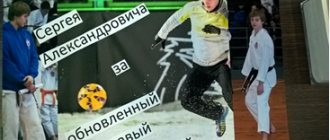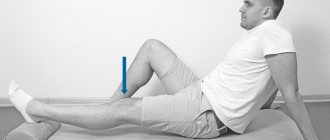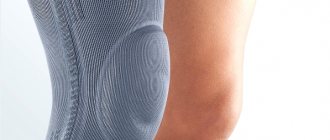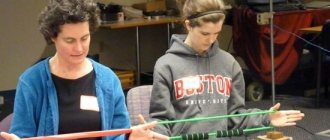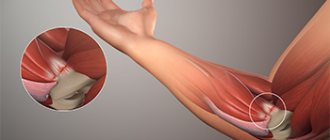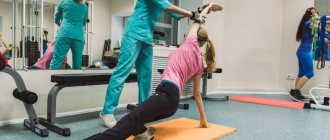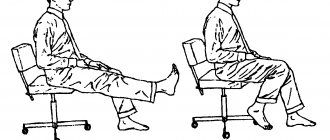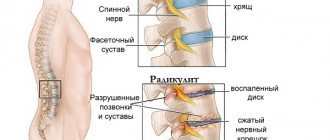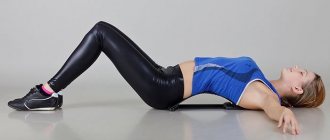The knee joint is the most commonly injured joint. Moreover, not only athletes, but also ordinary people can get injured due to age-related changes, awkward movements or turns of the leg. The most common pathology is a meniscus tear.
Exercise therapy for damage to the meniscus of the knee joint is an important part of rehabilitation. The method is aimed at restoring the full functioning of the leg. But only a competent specialist can correctly create a set of exercises that will help you quickly return to your normal life. If the ligaments of the knee joint are damaged, exercise therapy is used during the rehabilitation period.
Exercise therapy is used for various injuries of not only the knee, but also the shoulder joint.
Rehabilitation for a knee fracture
After removing the plaster or splint of the knee, it is necessary to undergo a course of rehabilitation in order for the joint to function fully in the future. Developing a joint requires a lot of effort and time. Even after the cast is removed, a repeat radiograph must be taken. To reduce the load on the joint, it is better not to give up crutches at first. That is why after an injury you need to exercise and go for a massage.
A few simple rules that will help restore performance and reduce rehabilitation time after a knee fracture:
- Activity. A sore leg needs time and exercise to recover. That is why the load must be given gradually.
- Simply walking will also help reduce recovery time. But you need to walk slowly, the speed should not exceed two kilometers per hour.
- It is best to use an exercise bike. It is necessary to exercise in such a way that the limb is fully straightened at the lowest point.
- Jumping is also useful, but only if the patient does not feel pain.
If there is even the slightest pain, then the exercise must be stopped. If you follow all the doctor’s instructions, do not forget about exercises and physical therapy, as well as massage, then in the near future the patient will be able to restore his working capacity.
Description of exercise sets
Passive period of rehabilitation
In case of injuries to the knee joint, the affected leg is immediately immobilized. For this purpose, fixing knee pads and cutting edges are used.
Physiotherapy exercises during this period are aimed at maintaining muscle tone and restoring blood circulation in the limbs. The leg is held in an elevated position, then the muscles are tensed in a lowered position. This sequence of actions makes it possible to prepare the injured leg for further training.
Important! Exercise therapy for damaged knee joints can only be prescribed by a doctor, who will determine the duration of training and the optimal physical load on the joint. You cannot do this on your own, since the risk of developing serious complications is high.
Exercises:
- Alternately, with smooth movements, raise and lower both legs. Repeat 8 times.
- Perform circular movements with your feet 12 times.
- Starting position: lying on your back. The knees are bent, the feet are pressed to the surface. Alternately tense and relax your feet for 5-7 seconds. If pain occurs, stop training.
- Starting position: lying on your stomach. The feet secure the roller. The injured limb straightens and relaxes.
Post-immobilization period
During the period of active rehabilitation, training is carried out in a gentle manner, with a gradual increase in physical activity. First, classes are conducted in a sitting position, then in a standing position, with the addition of walking.
The post-immobilization period includes a set of stretching exercises, coordination of movements, improving flexibility and endurance.
Exercises:
- The exercise is performed lying on your back. The victim rests on his elbows, a healthy limb, and the back of his head. Slowly lower and raise the pelvis without lifting the sore leg from the floor.
- Lie on the floor, the healthy leg straightens. The damaged limb is bent at a right angle, raised, and relaxed.
- Starting position: on all fours. The affected limb is slowly retracted and then returned to its place.
- They sit on the sofa, legs dangling. Limbs are raised and lowered alternately. This must be done carefully, the healthy leg should protect the damaged limb.
Exercises with increasing physical activity:
- Squats are performed while holding the back of a chair. Bend as low as possible, but do not allow pain.
- Slow walking on a treadmill is performed. It is necessary to hold on to the railing, the foot is rolled when walking from toe to heel.
- Use an exercise bike. The seat height must be adjusted so that the leg is fully straightened in the lower position.
- You will need a long elastic tape, which is attached to the wall bars at chest level. Run in place, holding onto the tape and placing one limb in turn against the other.
- You will need tape again, but fix it at a height of 20 cm from the floor. The patient moves a meter away from the wall, and the healthy leg is fixed in the loop of the tape. Swings the leg to the side.
- Perform while standing. The sore leg is lifted up, bent at a right angle, and relaxed.
Functional rehabilitation period
After surgery, to restore full functioning of the leg, a set of exercises is used that helps restore the functionality of the damaged limb. This course consists of an initial and a main part. Exercises differ in the intensity of physical activity.
Initial exercises:
- At a measured pace, bend and straighten the ankle joint. Repeat 15 times.
- Alternately raise your legs 15 times.
- They catch a medicine ball with their feet. The exercise is performed 10 times.
Main part exercises:
- Performed while standing on all fours. You need to slowly sit down on your heels and return to the starting position. Perform 6 times.
- You will need a terry towel, lay it out on the floor. You need to use your sore foot to gather the towel into folds.
- Holding the back of the chair, slowly squat 8 times.
- Performed at the gymnastics wall. Holding the bar near the chest, roll 15 times from heel to toe and back.
- They roll objects one by one with their feet. Either a medicine ball or a regular plastic water bottle will do.
Recovery
Exercise therapy during the recovery period consists of more difficult exercises that are as close as possible to natural movements. At this stage, exercises are performed for joints, muscles, and endurance is trained. The complex is selected by a specialist depending on the condition of the knee joint.
Exercises
- Exercises are performed to maintain balance.
- Run.
- Lunges.
- The knee is bent at an angle of less than 60 degrees.
- Exercises are introduced for correct landing when jumping.
Rehabilitation for an ankle fracture
To restore all functions of the ankle joint, the patient, along with traditional treatment, is prescribed nonspecific procedures - therapeutic exercises. You can begin to develop the joint already 2-3 days after immobilization of the limb. Each exercise at this stage of rehabilitation is aimed at achieving a specific goal:
- moving the toes of an injured leg helps quickly reduce swelling and restore blood circulation;
- flexion and extension of the injured leg at the knee joint allows you to maintain muscle tone;
- smoothly raising the leg up (in a straightened form) helps eliminate swelling and strengthens the muscles and ligaments of the leg.
The listed exercises should be performed as many times as the patient’s condition allows. If pain or noticeable discomfort occurs, gymnastics should be stopped.
Recommendations and useful advice from experts
To quickly restore the functioning of a sore leg, experts recommend:
- Exercise regularly.
- Visit the pool, perform exercise therapy in a warm bath.
- Eat right. Include fresh vegetables, fruits, and dairy products in your diet. Eat fish, do not abuse fatty foods.
- Take vitamins.
- Do not soak your foot in hot water.
And the main thing to remember is that for the speedy recovery of a diseased limb, not only the experience of the attending physician is important, but also the active participation of the patient in the rehabilitation process.
Rehabilitation for an elbow fracture
After removing the cast, it is imperative to undergo a rehabilitation course aimed at fully restoring joint mobility, returning sensitivity to the hand and restoring muscle strength. For this purpose, complex therapy is used, including:
- various types of hardware and manual massage;
- physiotherapy (mud therapy, balneotherapy), including hardware (UHF, electrophoresis);
- physical therapy;
- classes on special simulators;
- exercises with applicators.
Take note
In case of injury to the knee joint, performing this set of exercises will have a comprehensive effect on all links of pathogenesis, allowing you to return to normal life and begin full-fledged training as soon as possible. It must be remembered that the metabolism in connective tissue is very slow, and complete recovery will require considerable time. Typically, rehabilitation periods range from three months to several years. An integrated approach using various methods of physiotherapy, massage and chondroprotectors allows you to speed up the recovery process.
Rehabilitation for a fracture of the wrist joint
Rehabilitation after a fracture of the wrist joint is a very important stage, as it allows you to hone all the movements performed in this joint. If treatment is carried out without rehabilitation measures, then the patient cannot perform certain functions for a long time, and sometimes they may not recover at all. Rehabilitation measures include the following:
- development of the wrist joint after a fracture due to passive or active movements in it;
- physical therapy (physical therapy);
- massage.
Exercise therapy after a fracture of the wrist joint should be developed by a rehabilitation specialist. This is due to the fact that he knows which muscle groups and what load can be applied. This will allow you to properly restore the impaired joint function. Massage of the wrist joint after a fracture will help to cope with muscle atrophy that developed during the immobilization stage. The massage should be carried out for about a month with one-day breaks between sessions. It is in this mode that the course of recovery processes in muscle tissue will be optimal.
Rehabilitation for a shoulder fracture
Keeping the hand in a certain state for a long time has a negative impact on the muscles and mobility in the joint. As soon as normal fusion of the fragments has occurred, it is necessary to begin developing the shoulder joint after the fracture. All this can be accompanied by severe pain that requires painkillers. The development is carried out strictly under the supervision of the attending physician, who periodically prescribes X-ray examinations. During the examination, certain physical exercises are recommended. Rehabilitation activities require the following popular types of exercises:
- periodically raising the shoulder girdle 5-7 times;
- spreading and retracting the shoulder blades 5-7 times;
- flexion and extension of the forearm with the healthy arm, not reaching 90 degrees relative to the body, 5-7 times;
- with a small amplitude, flexion and extension of the shoulder 5-7 times.
A month after immobilization of the fragments, exercise therapy for a fracture of the shoulder joint can become more complicated. Now all movements should be accompanied by raising the arm to a horizontal level.
Rules for physical therapy
For gymnastics to be as effective as possible, you must adhere to the following rules:
- Movements should be smooth and measured.
- If pain occurs while performing the exercise, you should stop training and consult your doctor.
- Physical activity is increased gradually.
- To achieve the effect, gymnastics must be performed daily.
- Before training, the muscles need to be warmed up.
Important ! Failure to comply with the rules is fraught with aggravation of the patient’s general condition.
